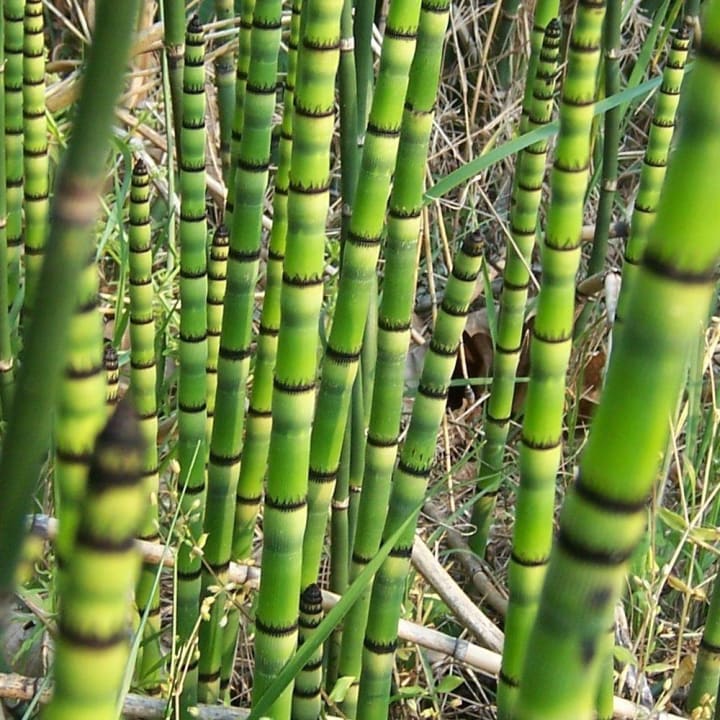Plants That Accumulate Heavy Metals
Plants With Gold In Their Leaves

By: Marlene Affeld
When out prospecting, have you ever noticed that some native plants flourish in one location and not another? Geobotany, the scientific study of the distribution of plants that hyper-accumulate heavy metals, has proven a valuable tool when prospecting for mineral anomalies, however it is one that is often overlooked in the search for gold deposits.
History Of Geobotany

History records writings about the correlation of plant growth and mineralized soil, from as early as the 5th-century B.C.: making note of not just the occurrences of particular plants, but their physiological condition and growth habits, with relation to mineral deposits. Unfortunately observations were lost as colloquial names used for indicator plants (plants peculiar to a particular place) resulted in unfathomable confusion.
By medieval times, Scandinavian miners, searching for copper, used Arctic Champion (Lychnis alina) as an indicator plant. Native to Europe and North America, Arctic Champion, is a delicate, low-growing (4-to-6 inches), tufted plant that grows in spreading (6-to-8 inch) mounds. Leaves are narrow, bearing small clusters of tiny brilliant pink blooms. The plant flowers in late spring and early summer. Arctic Champion thrives in poor, sandy, or gravel soils with neutral or acid pH. Native to North America and Europe, The plant is resilient and grows in damp, soggy areas: hardy, but happiest in cool-summer areas. Alpine Catchfly (Viscaria alpina, Silene suecica) is another perennial plant that grows in ultra-alkaline soils. Modern geo-botanists seek the plants location to identify copper-bearing regions of Sweden and Finland.
Back at the turn of the century, when scientists first entertained the belief that plants could be an indicator of gold, they thought that the plants absorbed micron gold blown by the wind that then settled on the leaves and was then absorbed into the plant. Wrong.
Scientists discovered gold in living plants in 1900: Emil Lungwitz, an American scientist and inventor, published articles about “the lixiviation of gold deposits by vegetation” in the Mining Journal.
By 1960, researches from the United States, Canada, New Zealand and Siberia confirmed this fascinating phenomena: certain plants absorb trace amounts of gold in their leaves, twigs, branches, and leaves.
Today, scientists have identified more than 85 different species of plants believed to indicate sites likely to be rich in a particular mineral or element: an impressive of list of plants that possess the natural ability to take up minerals and essential elements through their roots, concentrating metals such as gold, zinc, cadmium and nickel in their roots. Plants that indicate the presence of heavy metals are useful for a diverse array of reasons: they can tell us if the soil is acid or alkaline, if we are in a wetland, a mature woodland, or a human impacted site.
When scientists use the biochemical method to search for gold and other valuable minerals, the plant typically shows no evidence of abnormalities. As a useful indicator, the vegetation must be evenly distributed over the exploration area. One of the most impressive outcomes of the developing theories in geobotany was when biochemical research isolated significant deposits of uranium in the needles of pinon trees. Researchers reported that testing the material in the needles was a more accurate measurement than a shovelful sample taken from the base of the trees.
Melvyn Lintern is but one of many researchers in the field of geobotany. Lintern and colleagues from Australia’s Commonwealth Scientific and Industrial Research Organization have discovered high levels of gold in eucalyptus trees found growing in Western Australia. Additional exploration produced a huge deposit of gold hidden beneath layers of weathered rock beneath these very same trees. The obvious question is what does this mean and how did the gold come to be within the tree?
Extensive experiments conducted by Lintern and his colleagues determined that plants do collect minerals from the soil. This was demonstrated by cultivating arcadia and eucalyptus trees, grown inside a controlled greenhouse in pots of sand and gold ore. The researchers discovered that nanoparticles of micron gold were present in the leaf cells and the gummy exudates from the tree leaves. This test demonstrated that the plants can and do metabolically absorb gold ore through the soil.
While the quest for gold using plants as indicators is not exact, it certainly is intriguing. When studying trees in Australia, the concentration of the golden mineral trapped in leaves growing a distance of less than 800 feet from the gold deposit assayed at approximately 2 parts per billion. Trees growing on top of the deposit measured about 80 parts per billion.
Hyperaccumulators
Subsequent geobotany (also known as phytogeography) research reveals that plants in the Leguminosae, Lamiaceae, and Caryophyllaceae families are most prone to act as indicators or hyperaccumulators of heavy mineral accumulations.
The Leguminosae plant family includes chick peas, peas, and all types of beans. It also includes annual and perennial herbaceous plants, shrubs and trees. Plants in this family are recognized by their fruit (legume) and their stipulate, compound leaves.
Many of my favorite herbs are part of the plant family Lamiaceae: rosemary, thyme, horehound, lemon balm, sage, savory, and mint. This is a huge family of plants with more than 7,000 species. Plants in this family typically are highly aromatic flowering plants.
Plants in the Caryophyllaceae plant family include pinks and carnations. This is a plant family with more than 2,200 different species of both annuals and perennials. While they are different in habitat and appearance, most plants in this family have swollen leaves and stem joints.
Common Gold Indicator Plants Of North America
Crosby Buckwheat
Crosby Buckwheat (Eriogonum crosbyae) growing in areas of altered rhyolite, can act as indicator for gold or silver deposits nearby. Found in Montana, Nevada, Oregon, and Idaho, Crosby buckwheat typically grows at altitudes of 5,000 feet or higher in sparsely vegetated outcrops. The low growing, matted perennial herb displays gray wooly leaves with long stems and a profusion of bright yellow flowers. The plant blooms from early June through early August.
Desert Trumpet

Desert Trumpet (Eriogonum inflatum), also known as bladder stem or Indian pipe weed, is a gold indicator in the American Southwest. Experienced desert prospectors keep a sharp eye out for the Desert Trumpet plant, knowing it can lead them to gold nearby. Desert Trumpet is also a member of the buckwheat family. The plant thrives in rocky, mineral rich soil.
Sage

Four-wing saltbush and Big sagebrush have a long history of use by prospectors in the West as indicators of a gold deposit nearby. Science tells us that these two plants are not directly associated with gold, but that they do take up and absorb antimony and arsenic in their leaves, stems, twigs, and roots.
Horsetail

Gold found panning in stream beds did not originate there: rather it came from a gold vein in a rock outcropping somewhere upstream then eroded into flakes and tiny particles carried downstream by the current to be deposited where the current weakens. When I see horsetail, also known as field horsetail (Equisetum arvense) growing stream side, I tend to get a bit interested. An established patch of horsetail tends to flourish in an area where there is water, but not a strong current in any part of the year. Sighting horsetail does not tell whether or not there are gold deposits upstream, it does not tell if upstream currents are stronger, nor does it tell you how long the current situation has been in place. What it does tell you, is that horsetail is an indicator of one of prerequisites of finding gold. It's a helpful tip to use as in conjunction with other mineral indicators.
Indicator plants such as horsetail are not necessarily rare, however they don’t just pop up anywhere. Indicator plants are ones that only tolerate specific growing conditions. Their presence marks a distinctive aspect of that location. During the gold rush days, prospectors kept a keen eye out for horsetail. Horsetail has many uses and because of its high silica content is said to have medicinal value. However, to the gold seekers of old, it marked a stream side spot worthy of exploration. Horsetail tolerates the presence of heavy metals, in fact flourishes in mineralized soil, so when exploring the stream bed and you come across a flat of horsetail, the spot is worth a second look.
References:
United States Geological Survey - Absorption of Gold by Plants
https://pubs.usgs.gov/bul/1314b/report.pdf
NCBI - Heavy Metal Pollution from Gold Mines: Environmental Effects and Bacterial Strategies for Resistance
https://www.ncbi.nlm.nih.gov/pmc/articles/PMC5129257/
The Times of India - New technique to yield gold from crop plants
https://timesofindia.indiatimes.com/home/science/New-technique-to-yield-gold-from-crop-plants/articleshow/19542002.cms
Encyclopedia Britannica - Plants in the family Lamiaceae
https://www.britannica.com/topic/list-of-plants-in-the-family-Lamiaceae-2035853
PLOS – Ecological and human health risks associated with abandoned gold mine tailings contaminated soil
http://journals.plos.org/plosone/article?id=10.1371/journal.pone.0172517
Gold in plants
https://link.springer.com/content/pdf/10.1007/BF03215461.pdf
United States Forest Service -The Anatomy Of A Mine
https://www.fs.fed.us/geology/anatomy_mine.pdf
About the Creator
Marlene Affeld
“A passionate writer for more than 30 years, Marlene Affeld’s passion for the environment inspires her to write informative articles to assist others in living a green lifestyle.”






Comments
There are no comments for this story
Be the first to respond and start the conversation.